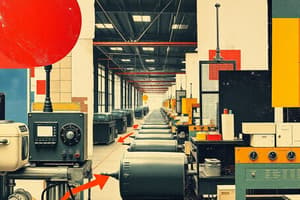Podcast
Questions and Answers
Ferrous materials contain iron as their main constituent.
Ferrous materials contain iron as their main constituent.
True (A)
Nonferrous materials contain iron in appreciable quantity.
Nonferrous materials contain iron in appreciable quantity.
False (B)
Ferrous materials can be significantly altered by heat treatment processes or by addition of small quantities of alloying elements.
Ferrous materials can be significantly altered by heat treatment processes or by addition of small quantities of alloying elements.
True (A)
Pure iron is relatively hard and strong.
Pure iron is relatively hard and strong.
Carbon rarely exceeds 2% in steel in actual practice.
Carbon rarely exceeds 2% in steel in actual practice.
The presence of cementite in steel makes it weaker and softer than pure iron.
The presence of cementite in steel makes it weaker and softer than pure iron.
Plain carbon steel is the only type of steel with carbon as the alloying element.
Plain carbon steel is the only type of steel with carbon as the alloying element.
High percentages of sulphur and phosphorus in steel have no detrimental effect on its properties.
High percentages of sulphur and phosphorus in steel have no detrimental effect on its properties.
Mild steel is extensively used for structural work and retains very good weldability up to 0.25% carbon percentage.
Mild steel is extensively used for structural work and retains very good weldability up to 0.25% carbon percentage.
Medium carbon steel has better weldability than mild steel and is used for making wire ropes.
Medium carbon steel has better weldability than mild steel and is used for making wire ropes.
Metal forming processes are also known as chemical working processes.
Metal forming processes are also known as chemical working processes.
Metal forming is possible for metals or alloys that are not malleable and ductile.
Metal forming is possible for metals or alloys that are not malleable and ductile.
Hot working metal forming processes result in better shape, size, and surface finish compared to cold working processes.
Hot working metal forming processes result in better shape, size, and surface finish compared to cold working processes.
Plain carbon steel is the only type of steel that does not contain any alloying element.
Plain carbon steel is the only type of steel that does not contain any alloying element.
Mild steel loses its weldability when the carbon percentage exceeds 0.25%.
Mild steel loses its weldability when the carbon percentage exceeds 0.25%.
Mechanical working improves the ductility of a material.
Mechanical working improves the ductility of a material.
Grain flow lines improve the strength against fracture in mechanically worked parts.
Grain flow lines improve the strength against fracture in mechanically worked parts.
Cold working occurs at a temperature above the recrystallisation temperature for the metal or alloy.
Cold working occurs at a temperature above the recrystallisation temperature for the metal or alloy.
Hot working involves plastic deformation of metals at a temperature where recovery and recrystallisation take place simultaneously with strain hardening.
Hot working involves plastic deformation of metals at a temperature where recovery and recrystallisation take place simultaneously with strain hardening.
The recrystallisation temperature for pure metals is roughly half of its melting point.
The recrystallisation temperature for pure metals is roughly half of its melting point.
Flashcards are hidden until you start studying




